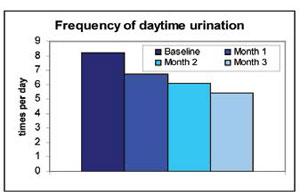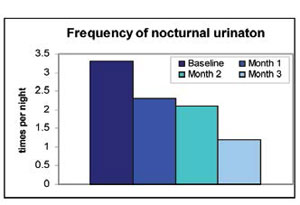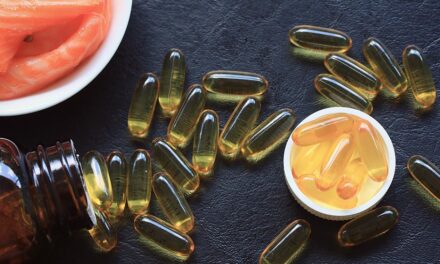The prerequisites for developing benign prostate hypertrophy (BPH) are the presence of testes and age. It is one of the most frequently occurring diseases in men over 60 years of age. According to the National Institute of Health (NIH), BPH affects more than 50 percent of men over the age of 60 and as many as 90 percent of men over the age of 70. This translates to a staggering 4.5 million visits to a physician for BPH in the United States in 2000.¹
What are the symptoms?
In the initial stages, a patient may experience increased urinary frequency during the day, nocturia (getting up at night to go to the toilet) and the sensations of not being able to empty completely. As the condition becomes more advanced, there is an increase in the obstructive symptoms characterized by the following: weak urine stream, difficulty starting urination, straining to urinate, stopping and starting again while urinating, dribbling at the end of urination, urgency, and pain on urination. If the BPH symptoms are severe, it may result in the inability to urinate. This can cause severe pain and discomfort. In addition, if urine is retained in the bladder for long periods of time, this can lead to urinary tract infections, bladder or kidney damage, or bladder stones.³
What is the primary risk factor?
It appears that age itself is the primary risk factor for developing symptoms associated with BPH.
Is there a link between hormonal changes during aging and benign prostate hypertrophy?
The exact cause of BPH is unclear, although researchers believe it may be caused by hormonal changes that occur during the aging process.
- Decreased testosterone levels: One theory is that as a man ages, the amount of testosterone in his blood decreases, leaving a higher proportion of estrogen in his blood. The disproportion of estrogen may contribute to cell growth within the prostate gland.
- Increased levels of dihydrotestosterone (DHT): Another possible theory is that as a man ages there is a hormonal change involving the accumulation of DHT, a by-product of testosterone in the body. If levels of DHT accumulate in the prostate,
- overgrowth of cells in the prostate can occur.³
What are the possible treatments?
Treatment for BPH depends on the severity of symptoms. Medications are the most common way to control mild to moderate symptoms of BPH. Watchful waiting, also known as observation, expectant therapy or deferred therapy, is often the preferred approach for men with mild symptoms who aren’t bothered by them.
—Pharmaceutical Medications
The most commonly used medications are alpha-adrenergic blocking agents which work by relaxing the smooth muscle tissue. Since there is a large number of alpha-adrenergic receptors in the bladder, the bladder neck and prostate gland, they cause relaxation and reduced tone, which then allows urinary flow. Although these drugs have been found to be effective, patients may experience side effects including headache, dizziness, low blood pressure, fatigue, weakness, and difficulty breathing. These are due to the fact the drug works on all smooth muscle tissue in the body, not just the prostate. The long-term risks and benefits have not been studied.&sup4;
The other common drug treatment is enzyme (5-alpha reductase) inhibitors that work directly on the endocrine system. They prevent the conversion of testosterone to the hormone dihydrotestosterone (DHT) and as a result reduces the size of the prostate itself. However, while studies have shown a decrease in symptoms it does not correlate with urinary flow rate and volume. In many cases, a treatment period of six months is necessary to see if the therapy is going to work. The side effects include reduced libido, impotence, breast tenderness and enlargement, and reduced sperm count. Again, these effects are due to the fact the drug may reduce the total testosterone in the body and the effects are not restricted to the prostate gland. The long-term risks and benefits have not been studied.
—Surgical Treatment Most doctors recommend removal of the enlarged part of the prostate as the best long-term solution for patients with BPH. With surgery for BPH, only the enlarged tissue that is pressing against the urethra is removed; the rest of the inside tissue and the outside capsule are left intact. Surgery usually relieves the obstruction and incomplete emptying caused by BPH.1 Surgery used to be the most common way to treat BPH. Today, its use is declining because of new medications and minimally invasive treatments. Surgery is usually used when non-surgical treatments fail or if there are BPH complications.²
—Complementary Medicines The principle goal of BPH treatment is to reduce excessive cell growth by inhibiting the conversion of testosterone into the more potent hormone dihydrotestosterone (DHT) and so preventing estrogen from attaching to receptors in prostate tissue.
Some supplements are intended to reduce symptoms while others will provide nutritional support. The combination of glycine, alanine, and glutamic acid can reduce urinary urgency, urinary frequency, and delayed micturition (initiation of flow). Beta-sitosterol may also help reduce symptoms of BPH. Betasitosterol also lowers cholesterol, which is important since high cholesterol levels can contribute to prostate hypertrophy. Flaxseed oil is a good source of the essential fatty acid (EFA) alphalinolenic acid (an omega-3 fatty acid). It is well-known that zinc is an important mineral for male health. Why? It may be related to the fact that zinc inhibits 5 alpha reductase and therefore lowers DHT production.
The most well studied herb is saw palmetto (Serenoa serrulata). Saw palmetto is a 5-alpha reductase inhibitor that inhibits the conversion of testosterone to DHT in the prostate, has an antiestrogenic effect, and helps improve all symptoms of BPH. Both pygeum (Pygeum africanum) and stinging nettles (Urtica dioica) may also reduce BPH symptoms although research is less conclusive.
Latest research— UrologicPros
One of the most recent exciting breakthroughs in this area has been the development of a unique herbal and mineral preparation, UrologicPros™, which has been clinically proven to be effective in reducing the urinary symptoms associated with BPH.
UrologicPros contains a patented formulation of herb ingredients, crateva and horsetail, which has been shown to be effective in treating the symptoms of overactive bladder in men and women with urinary incontinence. In this formulation, it has been combined with saw palmetto, zinc and selenium, which support prostate health.
In the most recent study, 33 men were asked to take UrologicPros (as an oral supplement) each day for a period of three months. Symptoms were assessed using a diary of urinary frequency (day and night) and the International Prostate Symptom Score.
There was a significant gradual reduction in daytime urinary frequency over the three months, for those with moderate and severe symptoms. There was also a significant reduction in episodes of nocturia over the three months.
There was an overall 40 percent reduction in symptoms over the three months. The median reduction (of individual results) was 45 percent with a range from (0–81 percent improvement). The greatest improvement was seen relating to nocturia, and urinary flow (particularly the symptom “difficulty emptying bladder”). The positive effect of the treatment on nocturia was seen within the first month, whereas the urinary flow symptoms improved most significantly after two months of treatment. There was also a significant improvement in quality of life reported as well. At completion of the study, 29 of the 33 subjects (88 percent) wanted to continue with treatment.

Figure 1: Average daytime urination frequency after treatment with UrologicPros

Figure 2: Average episodes of nocturia after treatment with UrologicPros
The inclusion of whole, fresh, unrefined, and unprocessed foods including fruits, vegetables, whole grains, soy, beans, seeds, nuts, olive oil, and cold-water fish (salmon, tuna, sardines, halibut, and mackerel) may help. It is important to remember that eating organic food helps reduce exposure to hormones, pesticides, and herbicides (which affect testosterone and estrogen balance). Optimal hormonal balance will occur in the absence of refined sugar and flour, dairy products, refined foods, fried foods, junk foods, and hydrogenated oils. There will be less stress on the bladder system itself if the amount of alcohol (particularly beer), and caffeine in the diet is reduced.
In summary, at present we have a limited understanding of the pathology underlying the symptoms associated with an enlarged prostate as men age. There are no specific pharmacological medications specific for the prostate (or drugs that do not have unwanted side effects in the body). Based on its current success rate, surgery should always be considered a last option when all other treatments have failed. However, there is increasing research directed at the role for individual and combined nutraceuticals in the management of urinary tract problems including BPH. Therefore, natural treatments should be considered as the first line of defense on the treatment of benign prostate hypertrophy.
References:
- National Institute of Diabetes and Digestive and Kidney Diseases, National Institutes of Health, NIH Publication No. 04–3012, Prostate Enlargement.
- Mayo Clinic. Enlarged prostate (BPH) guide.
- E Drug digest. Begin Prostate Hypertropy. www.drugdigest.org/DD/HC/Treatment/0,4047,550246,00.html &e=14911
- Urology Channel. Prostate.










